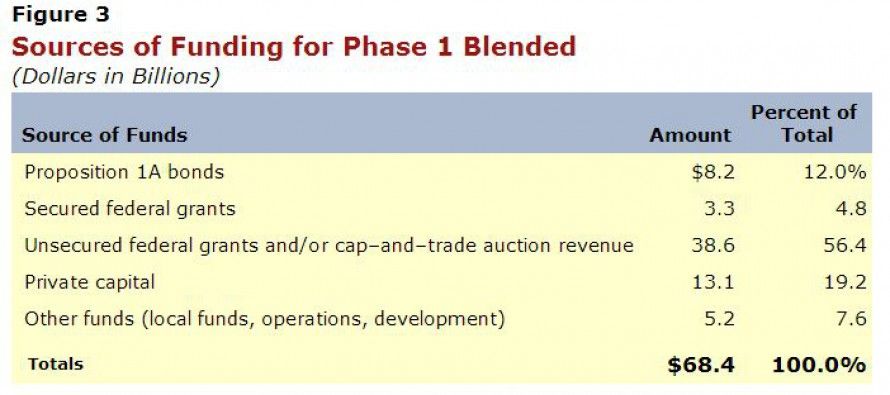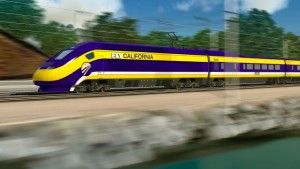High-speed rail: Where’s the money?

This is Part 3 of a three-part series on the new Draft 2014 Business Plan of the California High-Speed Rail Authority. Part 1 was about the questions raised by the plan. Part 2 was about California’s 3rd District Court of Appeal keeping the train chugging for now.
 The Godzilla roaring in the caboose of the High-Speed Rail project is: Where’s the money?
The Godzilla roaring in the caboose of the High-Speed Rail project is: Where’s the money?
The Draft 2014 Business Plan from the California High-Speed Rail Authority pegs the cost of the project at $67.6 billion, just a bit below $68.4 billion of the 2012 Plan.
And the new CHSRA plan identifies the main current funding sources to build high-speed rail as:
- $9.95 billion in bond money from Proposition 1A, which voters passed in 2008. (Of that, $950 million want to other transit projects, leaving $9 billion for high-speed rail.)
- $3.3 billion from the American Recovery and Reinvestment Act of 2009, President Obama’s stimulus program during the depths of the Great Recession. The ARRA funds were supposed to go to “shovel ready” projects and must be spent by Sept. 2017.
- An unspecified amount from state cap-and-trade revenues. This refers to the quarterly cap-and-trade auctions of “greenhouse gas emissions” begun by the California Air Resources Board in Nov. 2012. The auctions are carried out as part of AB32, the Global Warming Solutions Act of 2006, which mandated reductions in state greenhouse gas emissions to 1990 levels by 2020. That’s now only six years away and the first leg of the HSR system won’t be operable until two years later, in 2022.
The 2014 Plan reads:
“High-speed rail has been a priority investment for state cap-and-trade funding for several years, as described in the Authority’s 2012 Business Plan and the ARB 2008 Scoping Plan and recent investment plan. The 2012 Business Plan identified state cap-and-trade revenue as a potential backstop for the project.
“The Governor’s 2014-15 Budget … proposes to use cap-and-trade proceeds as an investment in statewide rail modernization in order to reduce greenhouse gases and modernize the state’s interregional transportation system (with $250 million for high-speed rail and $50 million for urban, commuter and intercity rail projects).”
Initial Operating Section
 The 2014 Plan then looks to the sources of funding for the Initial Operating Section of 300 miles. But as Exhibit 6.5 on p. 53 shows, Uncommitted Funds are $20.9 billion to finish the entire IOS.
The 2014 Plan then looks to the sources of funding for the Initial Operating Section of 300 miles. But as Exhibit 6.5 on p. 53 shows, Uncommitted Funds are $20.9 billion to finish the entire IOS.
This is a huge gap and this is one reason why Judge Michael Kenny (see below) said they had an illegal funding plan.
Yet the plan reads:
“First, combined with the remaining Proposition 1A bond funds, it will allow the Authority to proceed without delay and continue construction past the initial Madera to Bakersfield segment – to tunnel through the Tehachapis to create the first dedicated passenger rail connection between Northern and Southern California. Connecting to the multi-modal transit center in Palmdale, connecting rail service will be available throughout Southern California initially via the Metrolink commuter rail system.”
Metrolink, of course, is not a high-speed system.
Of the original $9 billion set aside for high-speed rail from Prop. 1A, only $4.4 billion has not yet been appropriated by the Legislature for the project. That’s what the 2014 Plan, as quoted above, calls the “remaining Proposition 1A bond funds.”
The quoted section assumes that the CHRSA will be able to get its hands on that $4.4 billion.
And that section also assumes that four things will not happen:
1. The bond funds, currently blocked due to court action, will be available. Just Tuesday, Sacramento County Superior Court Judge Michael Kenny ruled that “Kings County and two of its residents can forge ahead with a challenge to the California High-Speed Rail Authority over its statewide bullet-train plans,” as reported by the Fresno Bee.
2. A 50 percent match to the state bond funds can be found. Prop. 1A was put on the ballot in 2008 by AB3034. In Section 2704.08, that bill stipulated, “Proceeds of bond funds … shall not be used for more than 50 percent of the total cost of construction of each corridor or usable segment thereof of the high-speed train system.” That means half of the funds for the train must come from matching funds from the federal government or the private sector. So far, only $3.3 billion has come in from the federal government, as noted above. Nothing has come from the private sector.
3. Pressure from environmental groups might prevent the Legislature from appropriating cap-and-trade funds.
4. The LAO in January said using cap-and-trade funds for high-seed rail might not be legal.
Not as advertised
The new 2014 Plan details diverge from how the high-speed rail project was advertised to voters in 2008, and how the plan has been sold since then. The following chart is from the LAO’s April 2012 analysis; essentially nothing fundamental has changed in two years:
In reality, future federal funds for this project have been blocked by Congress and there is no current interest by private investors. That means the only solid funding for the Phase 1 Blended system is $8.2 billion (12 percent) from Prop. 1A and $3.3 billion (4.8 percent) from Secure Federal Funds. Total: $12.1 billion, or 16.8 percent of what’s needed.
Now in the 2014 Plan, cap-and-trade revenue is expected to fill that gap.
Skeptical Leg Analyst
In February, Legislative Analyst Mac Taylor released an analysis, “Cap-and-Trade Auction Revenue Plan.” As diplomatically as he could, Taylor says the train project doesn’t qualify for the cap-and-trade money.
His reasoning:
- As noted above, AB32 mandates greenhouse gas emission reductions by 2020. But the first part of the high-speed rail project wouldn’t be finished until 2022.
- Gov. Jerry Brown asked for $250 million from Cap and Trade for the 2014-15 budget. But he’s eying one-third of all cap-and-trade revenues in the future. Now, for the first five cap-and-trade quarterly auctions, from Nov. 2013 to Nov. 2013, $532 million in mitigation fees were collected. The LAO says several economists have estimated these fees would be substantially higher through 2020, as much as $15 billion. Yet no one knows for sure how much money will be raised because of many variables. There is also the question of the eligibility of the high-speed rail project, legal challenges and better choices available today to use the money.
- The LAO points out that the cap-and-trade fees, which required only a majority of voters for approval in Prop. 1A, are being challenged in court. As the Chronicle reported last November, the California Chamber of Commerce and the Pacific Legal Foundation “argued that California’s landmark global warming law, AB32, didn’t give state officials the authority to sell the allowances. Further, they said the allowances amounted to an illegal new tax, because the state legislature approved AB32 by a simple majority vote. Under California law, new taxes require the approval of two thirds of state legislators.”
- The LAO cautions the state to go slowly and develop measurable standards to prevail against legal challenges.
The Monte Carlo Model
The CHSRA came up with a new way to show that its assumptions are reasonable. It’s called the Monte Carlo Plan. It uses Monte Carlo Analysis, which Microsoft explains here for use on its Office programs, as a statistical tool for estimating “the probabilities of uncertain events.”
In brief, the CHRSA’s Monte Carlo Plan takes operating costs, maintenance and capital expenditures and simulates thousands of possible outcomes. The outcomes allow the CHSRA, in the 2014 Plan’s words, “to quantify and analyze the resultant potential variability in the estimate and determine the probability of different cost outcomes.”
Sounds complicated. But is it reliable?
CEO Jeff Morales thinks it is. He said at the Feb. 11, 2014 board meeting:
“[T]he Monte Carlo analysis shows that we can be very confident in those results by running some 5,000 variations of the different outcomes that produces then a level of certainty that is extremely high, that when we say we will hit the break even cost of this, meaning that we will not require a subsidy, a key component of Prop 1-A, we can say that with as close to 100 percent certainty as I think anybody could get. It is still a forecast, obviously, but by utilizing these tools, we’re able to provide a much higher degree of assurance of what that outcome will be.”
Note the phrase, “It’s still a forecast.”
Reality
William Warren has a different opinion. The Stanford MBA with 40 years of financial experience in Silicon Valley companies doesn’t think the Monte Carlo Analysis is useful or dependable for this project because of the large number of unknowns with the high-speed rail project. Along with a team of financial experts, he analyzed the HSRA’s financial reports.
He told CalWatchdog.com:
“The more you know about your reality, such as costs, and the less you have to define as unknown variables, the better off you are, as you are reducing the range of probable outcomes.
“Our friends at the Authority have very little data which is known (i.e. — based on facts) and a great deal which is unknown (and therefore must be estimated), so the range of results is very wide and very subjective. It is the classic house of cards. Actually, it is the classic case of an apartment complex of cards….
“I believe the truth test is found in this question: ‘Is there any HSR operator who believes the projected outcomes that show profitability, such that that the operator will sign an operations contract for the IOS, where they take a risk position based on these projections?’ So far it seems that the answer in ‘No.’ So why should the public believe these profitable projections?”
That’s a good question, and one that increasingly will be asked by legislators, the courts and Californians who voted for Prop. 1A.
Related Articles
High-speed rail seeks to run over CEQA
This is the first in a series of articles updating the status of the California high-speed rail project in the
Gov. Jerry Brown’s father complex
June 5, 2013 By John Seiler Calling Dr. Freud. Gov. Jerry Brown’s relationship with his later father, Gov. Pat Brown,
Video: CalWatchdog in depth — High Speed Rail (2)
CalWatchdog Contributor Kathy Hamilton explains how the California High Speed Rail Authority is destroying farms and dairies as they try





